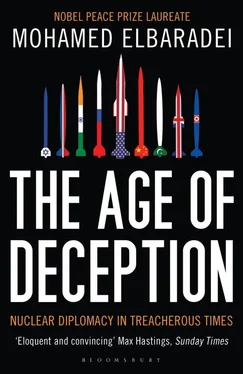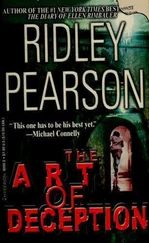The question put to me most frequently in off-the-record conversations—in one-on-one ministerial meetings, or by my seatmates in airplanes, or after reporters have turned off the tape recorder—is usually something like this: “What do you really think—is Iran trying to build a nuclear weapons program?”
My assessment is a gut feeling informed by historical context. First, elements of Iran’s nuclear procurement and research programs began in the mid-1980s, in the middle of the Iran-Iraq War. Iran was at the time under dire threat from Iraq; more than one hundred thousand Iranians, including civilians, reportedly fell victim to Iraq’s chemical weapons. Faced with this extreme sense of vulnerability, the Iranians might have originally intended to develop nuclear weapons. But at some point—perhaps after the war ended or in the mid-1990s, when records show abrupt adjustments to some of Iran’s nuclear programs, or perhaps after the Agency began its investigations—Iran may well have decided to limit its program to the development of the nuclear fuel cycle, legitimately remaining a non-nuclear-weapon state party to the NPT.
In any case, my belief is that Iran has not revealed the whole truth about the beginning of its nuclear program. There might have been some military involvement in nuclear procurement and nuclear experiments. However, these skeletons in the closet are, in all probability, fairly insignificant; the body of evidence would otherwise be greater and harder to conceal.
My impression is that Iran might have intended finally to come clean about any past weapons ambitions during their negotiations with the Europeans, as part of a comprehensive package and a pre-agreed scenario and at a time when the world’s focus was on Iran’s future and not its past. But when the negotiations fell apart and the environment turned confrontational, the Iranians were left with a dilemma: any revelation of past involvement in a military nuclear program, however minor or distant, coming during a moment of confrontation, would be seen as vindication of the view that Iran was not to be trusted. But if they refrained from giving a full account, they were perpetuating the original sin of concealment. [14] According to rumor, certain Iranian officials had admitted that Iran had appointed a special group in 1987 to look into planning a nuclear weapon option. The group allegedly had been disbanded in the early 1990s. Reportedly, Iran was divided internally about how to confess this matter to the IAEA. The Agency had heard similar intimations through intelligence channels. But we were never able to verify the truth behind these rumors.
A second question frequently posed to me is why Iran has remained so intent on pursuing uranium enrichment in the face of sanctions and Western condemnation. My best reading is that the Iranian nuclear program, including enrichment, has been for Iran the means to an end. Tehran is determined to be recognized as a regional power. That recognition, in their view, is intimately linked to the achievement of a grand bargain with the West.
Even if the intent is not to develop nuclear weapons, the successful acquisition of the full nuclear fuel cycle, including enrichment, sends a signal of power to Iran’s neighbors and to the world, providing a sort of insurance against attack. Each of the factions in Iran understands that the nuclear program is in itself a deterrent. There is a clear consensus domestically that Iran needs to maintain that deterrence. Overall, though, Iran’s goal is not to become another North Korea—a nuclear weapon possessor but a pariah in the international community—but rather Brazil or Japan, a technological powerhouse with the capacity to develop nuclear weapons if the political winds were to shift, while remaining a non-nuclear-weapon state under the NPT.
The furor over Iran’s nuclear program cannot be understood without reference to the volatile security situation in the Middle East and the region’s fiercely competing ideologies. The elephant in the room is Israel’s nuclear arsenal. Israel of course is not in violation of the NPT, having never joined, but that distinction does nothing to temper the anger of its neighbors at the perceived asymmetry in treatment and the imbalance in regional security.
Meanwhile, as all efforts to reach a negotiated agreement over Tehran’s nuclear program failed, Iran continued to consolidate its position as the most powerful Islamic player in the region. The ongoing wars in Iraq and Afghanistan, the continuing plight of the Palestinians, and the West’s resistance to a cease-fire during the mid-2006 Lebanon War, among other developments, reinforced the perception of Western prejudice against Muslims. With Iran being one of the few Muslim countries that stood up to the West during this period, it increasingly was viewed by Muslims of many nationalities as the sole defender of their trampled rights. [15] Turkey has also taken a number of anti-Western stances under Prime Minister Recep Tayyip Erdoğan’s leadership, which has gained him immense popularity in the Muslim world. Turkey is a member of NATO and considered a Western ally, but there has been considerable controversy over its candidacy for membership in the European Union, which has been cited by Muslims as proof of Western bias against them.
In dealing with complex nuclear verification cases, I have consistently made the distinction among three aspects of nuclear programs. The first is knowledge acquisition of the various aspects of nuclear technology, which is easier now than ever before. With the globalization of finance, industry, education, and, most of all, information, it has grown exponentially more difficult to deny states the basic knowledge of nuclear processes and techniques. The second aspect is industrial capacity: that is, the ability to enrich uranium or separate plutonium at an industrial level. Capacity of this sort gives states the ability to produce the nuclear material necessary for use in nuclear weapons. The third aspect relates to a state’s future intentions, which are sometimes quite difficult, if not impossible, to judge.
The IAEA Secretariat is able to determine a country’s knowledge acquisition and industrial capacity, but we are not in a position to judge future intentions, which are based on the country’s risk assessment and are subject to rapid change. Libya’s decision to come clean, for example, was the result of a reassessment of its security situation that led, in a very short time span, to a change in its intentions. Japan, which is regarded as having impeccable nonproliferation credentials, had officials calling for a discussion of its nuclear weapons stance after the North Korean nuclear test in October 2006.
It is often difficult for the public—or, for that matter, government officials—to understand or accept the IAEA’s unique verification role, with both its limits and its obligations, because it is rare for an international institution to sit in judgment on sovereign governments. Our position is somewhat schizophrenic: on the one hand, Member States pay the Agency’s salaries and set its direction and mandate; on the other, we are charged with judging their compliance with international commitments under a treaty they have pledged to uphold. Even though Member States might understand this IAEA role intellectually, in the abstract, and when it applies to others, we inevitably encounter some resistance when we report a government’s failure to comply with their obligations.
Despite my attempts to define the scope of the IAEA’s jurisdiction consistently and to draw a clear distinction between what the Agency can and cannot judge, the pressure was often extreme for us to behave in a partisan way. When we held fast to our objective evaluation of the facts, when we refused to lend our voice to someone else’s interpretation of a country’s intentions, we were sometimes accused of playing favorites, of ignoring evidence, or, conversely, of speaking “outside the box,” beyond the limits of our jurisdiction.
Читать дальше












